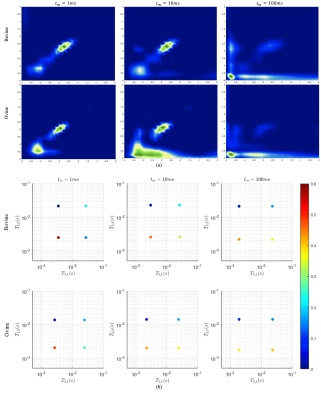Muhammad Ali Raza Anjum1, Anshuman Swain 1, Johannes Leisen2, Felix Gonzalez1, and David Reiter 1
1Emory University, Atlanta, GA, United States, 2Georgia Tech, Atlanta, GA, United States
1Emory University, Atlanta, GA, United States, 2Georgia Tech, Atlanta, GA, United States
Intermediate exchange in tendon causes bi-component model to underestimate short pool population and overestimate long pool population/decay rates. Two-pool exchange model can be more specific to structural/biochemical changes in pathological tendon.

Figure 2. Representative T2-T2 relaxation spectra of bovine and ovine Achilles tendon obtained from 2D-ILT8 (panel a), and those reconstructed from 2D-SMA
estimates (panel b) of two-dimensional proton T2-T2 relaxometry NMR data.
Mixing time, $$$t_{m}$$$ , is 1, 10, and 100ms. T2 axes in 2D-ILT spectra are
displayed in log10 scale (seconds). (2D-ILT = two-dimensional inverse Laplace
transform; 2D-SMA = two-dimensional subband Steiglitz-McBride algorithm.)

Table 1. Mean exchange-rate estimates of T2-T2 correlation
relaxometry data and the mean apparent and inherent bi-component estimates of
proton NMR data of bovine (N=3) and ovine (N=3) Achilles tendon samples.
Percentage increase in the apparent estimate value in the presence of exchange
is also displayed, computed as: 100$$$\times$$$(apparent estimate - inherent estimate)/ inherent estimate.